MXA RACE TEST: THE REAL TEST OF THE 2023 HUSQVARNA FC250
 THE GEAR: Jersey: Thor MX Reflex, Pants: Thor MX Sector, Helmet: Thor MX Sector, Goggles: Scott Fury, Boots: Sidi X-Power.
THE GEAR: Jersey: Thor MX Reflex, Pants: Thor MX Sector, Helmet: Thor MX Sector, Goggles: Scott Fury, Boots: Sidi X-Power.
Q: FIRST AND FOREMOST, IS THE 2023 HUSQVARNA FC250 BETTER THAN THE 2022 FC250?
A: It is better, but not right away. We’ll explain later in this test.
Q: WHAT’S NEW ON THE 2023 HUSQVARNA FC250?
A: The 2023 Husqvarna FC250 has been totally rebuilt from the ground up. The front wheel, brakes, handlebars and ODI lock-on grips are practically the only aspects of this bike that remained the same. The engine and frame make the biggest difference on the new Husqvarna. The 2023 engine has a bigger bore and shorter stroke than before, up from 78.0mm by 52.3mm to 81mm by 48.5mm. This creates room at the top of the cylinder for larger intake and exhaust ports. Plus, to centralize mass and reduce chain torque, the engine was tilted 2 degrees backwards (when compared to last year’s position). It also has an 8mm-shorter total height and 3mm-lower countershaft sprocket. Additionally, the compression ratio was increased from 14.4 to 1 to 14.5.
As for the frame, it was redesigned to provide exceptional rider feedback, energy absorption and straight-line stability. One change that is noticeable right away is that the frame doesn’t squat as much when you’re on the gas or braking. That was achieved by moving the countershaft sprocket down, along with adjusting the rotating mass of the engine and stopping the frame’s backbone from extending from the steering tube to the top of the shock. With the shock not connected to the frame’s backbone, the frame’s tendency to transmit added hand fatigue from square-edge bumps is reduced. Also, the wall thickness of the frame has been optimized to achieve improved reliability and rigidity in high-stress areas, such as the steering head and the shock mount. Also, the matching parallel frame tubes improve the chassis’ flex characteristics and stability.
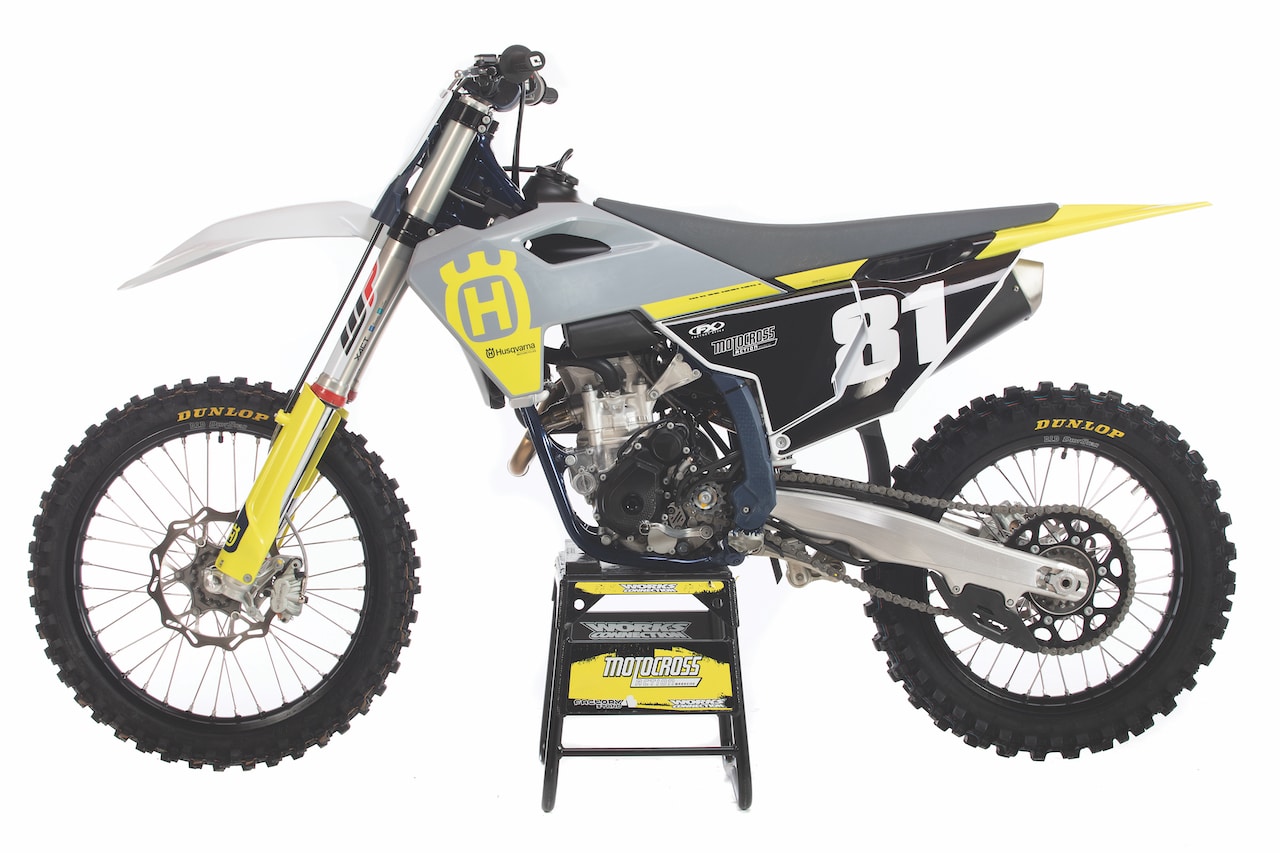
Q: WHAT’S DIFFERENT BETWEEN THE KTM AND HUSQVARNA FOR 2023?
A: Great question. There are a few differences. In previous iterations, the subframe design and materials differentiated the Husqvarna and KTM. KTM’s subframe was made of aluminum, while Husky used a carbon composite plastic subframe. For 2023, they both share the same style subframe (ironically made of both aluminum and carbon composite); however, there’s still one big difference. The KTM has two massive air vents in its subframe just below the seat to open up the airbox. The Husqvarna has fake air vents that look like the KTM vents but are molded shut.
KTM’s management intentionally tones down Husqvarna’s ability to breathe every model year to create different power characteristics between the two brands. It always results in a better throttle response for the orange bike but not a massive difference in overall peak power.
The Husqvarna chassis is also lower than the KTM’s (we’ll get into that below). The bike comes with ProTaper-branded handlebars (rather than KTM’s Neken handlebars), and, of course, Husqvarna has its own bodywork and color palette.

Q: HOW DOES THE 2023 HUSQVARNA FC250 RUN ON THE DYNO?
A: If you have read our test on the 2022-1/2 Husqvarna FC250 Rockstar Edition in the July issue of Motocross Action, you know how it runs on the dyno already, because this engine, exhaust, ECU, airbox and airbox cover are all the same. In case you haven’t read it, or you forgot what it said, we’ll break it down for you.
All the way up to 9500 rpm, the 2023 Husky engine is slightly stronger than last year’s Husky. Where the R&D team members earned their paychecks is in the 9500 to 13,800 rpm range where the new powerplant makes 1 horsepower more all the way through. Surprisingly, the peak horsepower for the all-new engine landed right next to last year’s six-year-old FC250 engine at 44.6 horsepower, with the 2022 making 44.3 horsepower. When it comes to torque, both engines peak at 21.0 pound-feet.
Q: HOW DOES THE 2023 HUSQVARNA FC250 RUN ON THE TRACK?
A: In the dirt, the 2023 FC250 gets up and goes; however, it actually lost some of the initial throttle response that the 2022 FC250 engine had. Comparing this new-generation 2023 Husky FC250 to the Yamaha YZ250F, Honda CRF250, Suzuki RMZ250, GasGas MC250F and last year’s KTM/Husky engines, it’s less exciting at the snap of the throttle, but it picks up quickly after that. Once on the pipe in the bottom, middle or top, the 2023 Husky FC250 feels like it is one step above the 2022 bike all the way through the rev range. It doesn’t hit harder in any particular area, it just has more juice all the way through. Overall, even with a stronger midrange, the FC250 engine is still a high-rpm screamer that needs to be revved to squeeze all the power out of it.
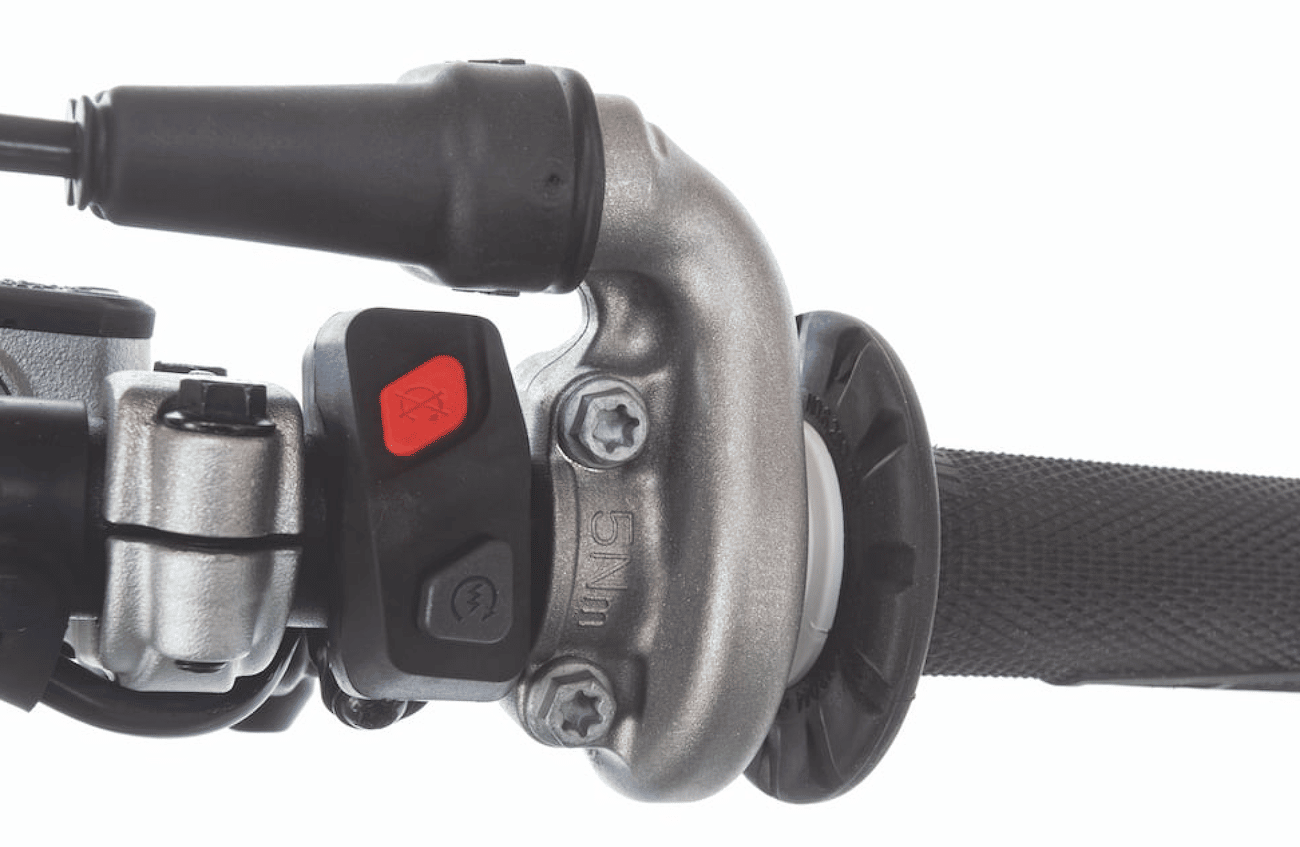 The electric start button and red kill button are both on the same switch on the throttle side of the handlebars.
The electric start button and red kill button are both on the same switch on the throttle side of the handlebars.
Q: HOW ARE THE UPDATED 2023 FC250 ELECTRONICS?
A: The MXA wrecking crew has always complained about the lack of separation between Map 1 and Map 2 on Husqvarnas (and KTMs). For 2023, the Austrians did their best to make the maps different, and they succeeded. The differences between the two maps were noticeable enough that all of our test riders made sure that they stayed in the green map (Map 2) for the entirety of their testing. It didn’t take long for anyone to figure out that Map 2 revved quicker and produced more usable oomph. Map 1 was slower, which made the FC250 easier to hold on to; however, most of our testers don’t have a problem holding on to 250 four-strokes, so they stuck with Map 2. Obviously, a mellow map on a FC250 is less important than it is on an FC450, because the 250 needs all the power it can get while a 450 four-stroke needs to be manageable.
How was the traction control? Great question. It was horrible! In the past, Husqvarna has touted that its ECU monitors the engine’s rpm, and, when there’s a sharp spike in runaway revs, it retards the ignition timing to stop the rear wheel from breaking loose. On the 2022 and prior-year bikes, we believed them. Riding in “TC” mode didn’t make an incredible difference on those bikes, but our testers would use it when the track was slick, hard-packed or exceptionally rough at the end of the day. Now, on the 2023 FC250, traction control is atrocious. It feels like it detunes the bike by 25 percent on the track, which is far too much. The “TC” mode also makes the bike sound too rich.

Q: HOW LONG DOES IT TAKE FOR THE 2023 FC250 TO BREAK IN?
A: This goes back to the first question that we said we would answer later. Well, here is the answer: The 2023 Husqvarna FC250 doesn’t handle as well as the 2022 Husqvarna FC250 until about the eight- to 10-hour mark. Why? That’s how long it takes for the chassis to break in. In the past, the WP XACT air forks have broken in quickly for us. After the first two hours, they were normally comfortable, and then they kept improving with time. We should, however, mention that the 2023 WP XACT air forks that required much more time before they started working properly. The new-generation KTM/Husqvarna motorcycles (with the new frame, engine, subframe, swingarm and shock) take twice as long to break in as the 2022 models. Our test riders felt that the engine kept getting faster and more free-revving as it got more time on it, but in our experience, which includes test time on the 2023 Husky FC250, FC350 and FC450, the whole machine reaches its optimum feel in terms of resilience, compliance and plushness at the 10-hour mark.
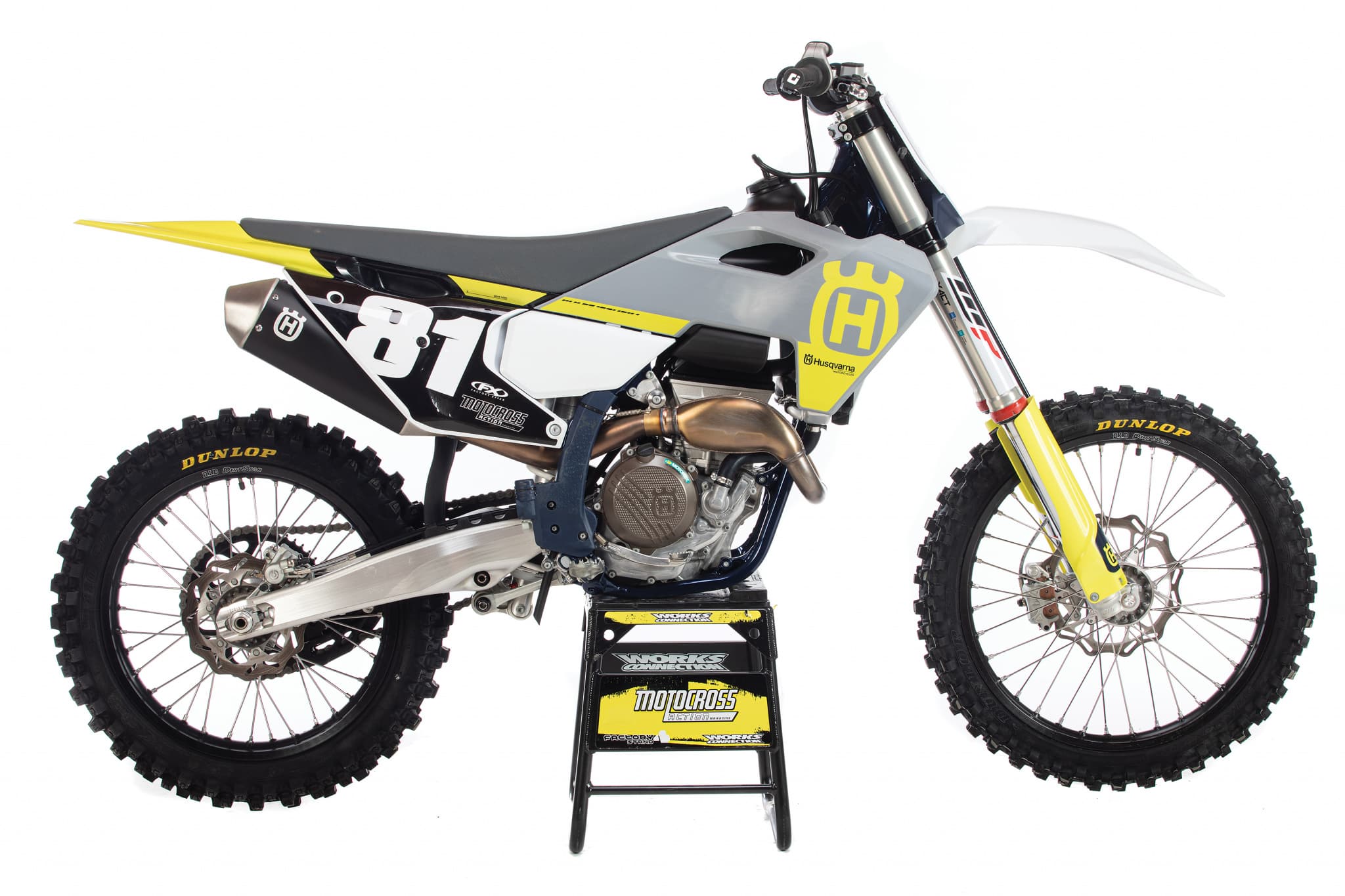 The 2023 Husqvarna FC250 is all new, sharing its frame and engine with the 2023 KTM 250SXF.
The 2023 Husqvarna FC250 is all new, sharing its frame and engine with the 2023 KTM 250SXF.
Q: HOW DOES THE 2023 FC250 HANDLE ON THE TRACK?
A: After the dreadful break-in period mentioned above, the FC250 comes into its own. The FC250 carves through corners with ease. Every MXA test rider appreciates the magic tricks that this bike pulls off in every corner. When the conditions are dry and slick and you think traction is long gone, the FC250 hooks up and turns. When you want to dodge a massive rock that just fell into your line, the Husky turns. When a rider tips over in front of you, the Husky turns. Don’t get this wrong, the 2023 FC250 is not a “turn at all costs” motorcycle that is unstable on the straights. The turning prowess doesn’t come from a steep head angle; it comes from a lower center of gravity. With the bike (and rider) closer to the ground, turning is like magic.
In the bumps, the Husqvarna FC250 is still good. For MXA’s Intermediate- and Pro-level test riders (or riders in the 175-pound range), the 42 N/mm shock spring is on the soft side. But, for test riders in the 150- to 160-pound range, it was great. Plus, everyone appreciates the fact that you can dial in the forks for a wide range of riders with a simple WP hand pump. Not to mention that every fork and shock adjuster on the bike can be turned by hand—no tools necessary (well, maybe on the shock rebound damper, where the clicker is obstructed by the link arms).
One faulty part that you should be aware of is on the shock linkage bearing. On our 2023 Husky FC250, the needle bearing backed out on the shock linkage’s bell crank. This hindered movement of the shock linkage. A slow-moving linkage, and especially one that is stuck in place, won’t allow the shock to work properly and causes your rear end to feel dead. To check to see if you’re having this issue, remove the bell crank knuckle, place it in a vise and test each of the three slots to see if the bell crank rotates smoothly or gets hung up. If your linkage is hanging up, replace the needle bearings with a new caged bearing—KTM part number 58033097000.
Q: IS HUSQVARNA’S LOWERED SUSPENSION CONCEPT A BIG DEAL?
A: If you go on the Husqvarna website, it says the bike is 10mm lower. If you read Motocross Action, we say it’s 1 inch lower, which is 25.4mm. How can there be such a difference between MXA’s calculations and Husqvarna’s? It’s simple. We explain how tall the bike is for us, how tall it is in the pits, how tall it feels when you sit on it and how tall it feels on the track. Because Husqvarna is a large corporation, they can’t do that‚ they have to use a numerically calculated measurement of the mechanical parts. When MXA measures the seat height, we obviously take into account that the swingarm is a lever and the movement at the end of the lever is much greater than the movement at the fulcrum. Based on our comparison of the 2023 Husqvarnas and 2023 KTMs, the Huskys are at least an inch lower in the rear and the forks are 10mm shorter (this varies with the fork height in the triple clamps).
The difference between a low Husky and a high KTM is noticeable but not a deal-breaker. When you ride the Husqvarna all day, it doesn’t feel low. It feels normal until you hop on a KTM, then the KTM feels tall; however, when you ride the KTM all day, it feels normal, but when you jump on a Husky, it feels low. In the opinion of most—but not all—MXA test riders, the 2023 KTM 250SXF is too tall. Test riders never complain about the Husky being too low, but they do complain that the KTM is too tall.
We’ve heard some riders complain that the lowered Husky cockpit is too cramped, but this is nonsense. The distance from the footpegs to the seat and seat to the handlebars is exactly the same as on the KTM. It’s the exact same cockpit; the difference is in the Husqvarna’s suspension, not its chassis. The seat on the Husky is closer to the ground, but most riders find this to be a positive and not a negative.
Q: HOW ARE THE NEW SUSPENSION ADJUSTERS?
A: The Husqvarna is very user-friendly with its new adjust-by-hand clickers on the forks and the shock. The WP forks have had plastic compression adjusters on the forks for years, and in 2021, the forks gained the same style adjuster on the bottom of the right fork leg for the rebound. This year, WP brought the same ideas to the high-speed, low-speed and rebound adjusters on the shock, too. The high- and low-speed adjusters on the shock body are easy to use, but the rebound adjuster, located at the bottom of the shock, is difficult to access because it’s hard to get your hand past the linkage. Luckily, there’s a spot where a flat-bladed screwdriver can get to the slot in the adjuster.
In what was probably MXA’s favorite update for the WP suspension, the shock gained a much-improved preload collar. We’ve hated the stock shock collar for years, but when we complained about it to the KTM test department, they would tell us that because MXA changes test riders so many times in a day, we don’t represent the typical user who sets his shock preload once and forgets it. That is true. MXA test riders do set the sag multiple times a day when they switch between bikes. But, we also know that anyone paying over $10,000 for a brand-new bike hates to see plastic chunks flying off the plastic collar when setting their sag. We almost lost hope, but for 2023, WP redesigned the shock collar to make it more durable and to allow it to spin easier.
Q: HOW IS THE NEW HUSQVARNA BODYWORK?
A: It’s obvious that the R&D department for KTM and Husky spent all of its time testing the 2023 shock on the KTM platform, because the Husqvarna plastics don’t make any sense. Husqvarna had to add a hokey, ugly, ill-fitting, separate plastic cover to fit over the shock adjusters. KTM didn’t need this piece of extraneous foof’ because its side panels cover the shock adjusters. Not the Kiska-designed Husqvarna side panel; it stops before it gets to the shock adjuster. The 2023 shock compression dampers have large adjuster knobs, and without the added plastic cover, a Husky rider’s boot could turn the compression clicker every time the rider leaned back on the bike.
This didn’t have to happen, because it happened once before at KTM. In 2002, KTM designed an all-new shock with a plastic knob to handle compression adjustment by hand. It was a weird shock in that you turned the knob in to lessen compression damping, and you turned the knob out to increase compression damping (opposite of any other shock made). The real problem was that the knob stuck out far enough that the rider’s boot could rub against the knob. And, when the boot rubbed against the 2002 clicker, it increased the compression damping so much that by the end of the moto the shock would be rigid.
Fast-forward to 2023, and the Husqvarna bodywork failed to cover the shock’s compression clickers, resulting in a slap-on, slap-dash piece of plastic that fixes a problem that Kiska created in the first place.
Q: DID HUSQVARNA FIX THEIR SPOKES FOR 2023?
A: When they told us that the 2023 models had all-new spoke nipples, we thought things would be better, but the 2023 Husqvarna spokes come loose even quicker than before. It’s taken up to six hours for some of the spokes to take a set. Be sure to tighten the spokes (with a spoke torque wrench) before you ride your first moto, and check them after every moto until you’re sure they’re staying put. If you let the spokes come loose on your first ride, dirt can get into the spoke’s threads and only make your problem last longer.
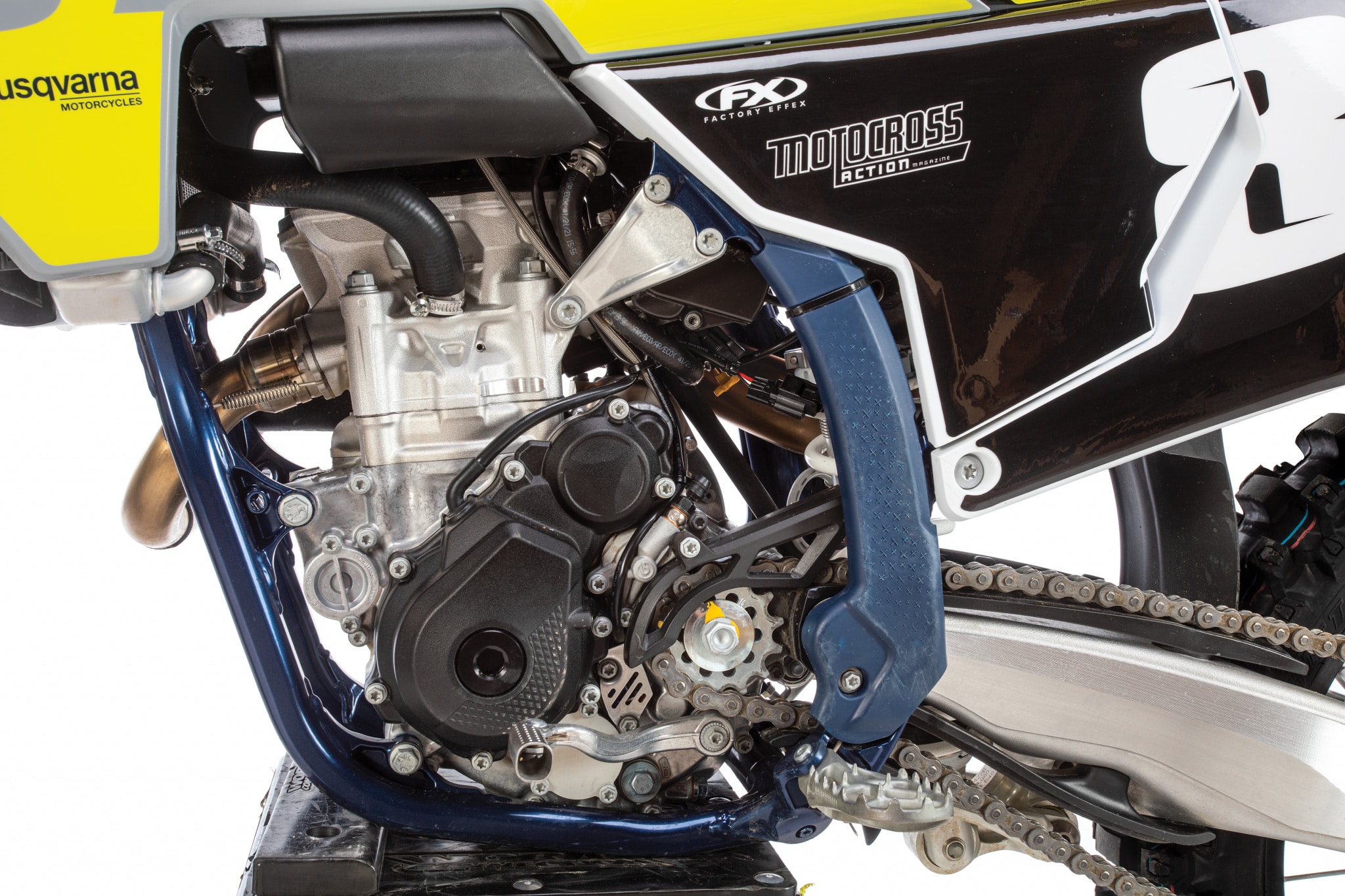 The Husqvarna FC250 engine is stronger than before with more power in the mid-range. It still likes to be revved.<
The Husqvarna FC250 engine is stronger than before with more power in the mid-range. It still likes to be revved.<
Q: WHAT DID WE HATE?
A: The hate list.
(1) Spokes. This spoke problem is getting very old! We don’t have this much trouble with Japanese wheels.
(2) Traction control. They muted the engine too much for 2023. The new TC mode is insane.
(3) Radiator cap. We didn’t have issues with the bike overheating or losing coolant, but the plastic radiator cap is off their minibikes. It is difficult to take off.
(4) Shock cover. This cover is an afterthought. If they had thought about it a little bit more, it wouldn’t be necessary.
(5) Weight. The FC250 went from 219 pounds to 224. That’s never a good sign.
(6) Slide-N-Guide. With the new lowered countershaft sprocket, the durability of the chain buffer guard has gone down. We recommend TM Designworks.
(7) Aesthetics. The plastic color combo is white, grey and yellow. The frame, on the other hand, is blue, but nothing else on the bike is blue. We liked it when Huskys were all white.
(8) Price. No matter how much technology is added on the bike, $10,099 for a 250 just feels like too much.
(9) Linkage. It’s a bummer that the 2023s are coming with faulty bearings in the linkage. So far, two of our six test bikes have had this issue.
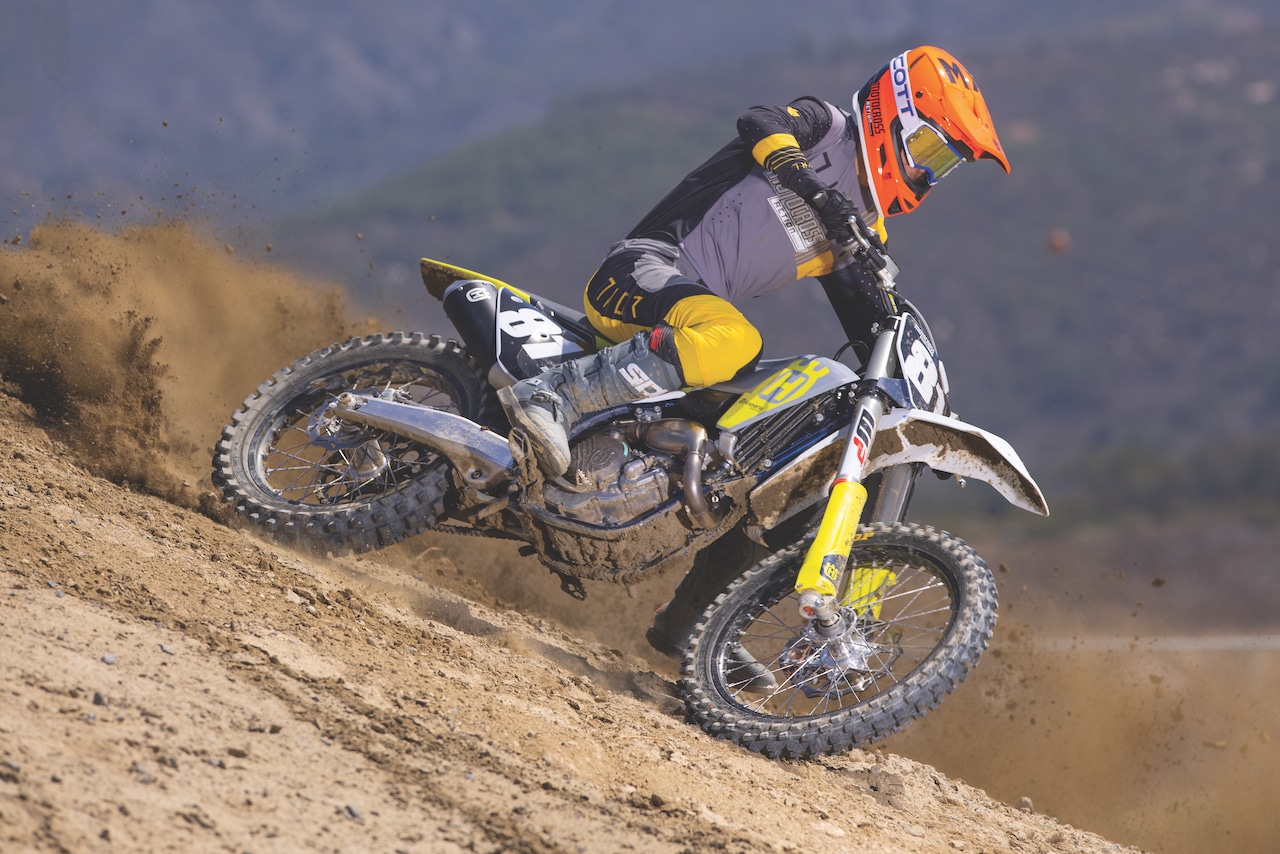
Q: WHAT DID WE LIKE?
A: The like list.
(1) Seat height. We’re very happy with Husqvarna’s lowered suspension. We think every brand should bring their seat height down.
(2) Shock collar. The new shock collar is everything we hoped and dreamed it would be.
(3) Engine. We thought the big-bore 2023 engine was going to be a game-changer. It is stronger in the midrange but not mind-blowing.
(4) Air forks. Take the time to let the forks break in. Learn how to choose the proper air pressure and check it throughout the day.
(5) Brakes. The Brembo brakes are still great!
(6) Handling. The Husqvarna corners like a dream and is comfortable for a wide range of testers.
(7) Quick Shift. Although most of our MXA testers don’t like “Quick Shift” on the track; it’s fun to play with it and doesn’t hurt anything.
Q: WHAT DID WE REALLY THINK?
A: The 2022 Husqvarna FC250 won “MXA’s 250 Shootout” the last two years in a row, so we had high expectations when they introduced a new engine, frame and bodywork. The stiffness of the frame and the long break-in period it requires have bummed us out. We believe that many riders who buy a 2023 FC250 and ride it for the first time will blame the air forks, when really the bike itself needs to be broke in. This bike isn’t as user-friendly as the 2022 FC250 because it is more sensitive to suspension changes. One click on compression and a 2mm increase in sag makes a bigger difference now than before. The 2023 Husqvarna FC250 is a better motorcycle than the 2022 model; however, it took us time to figure that out.
MXA’S 2023 HUSQVARNA FC250 SETUP SPECS:
This is how we set up our 2023 Husqvarna FC250 for racing. We offer it as a guide to help you find your own sweet spot.
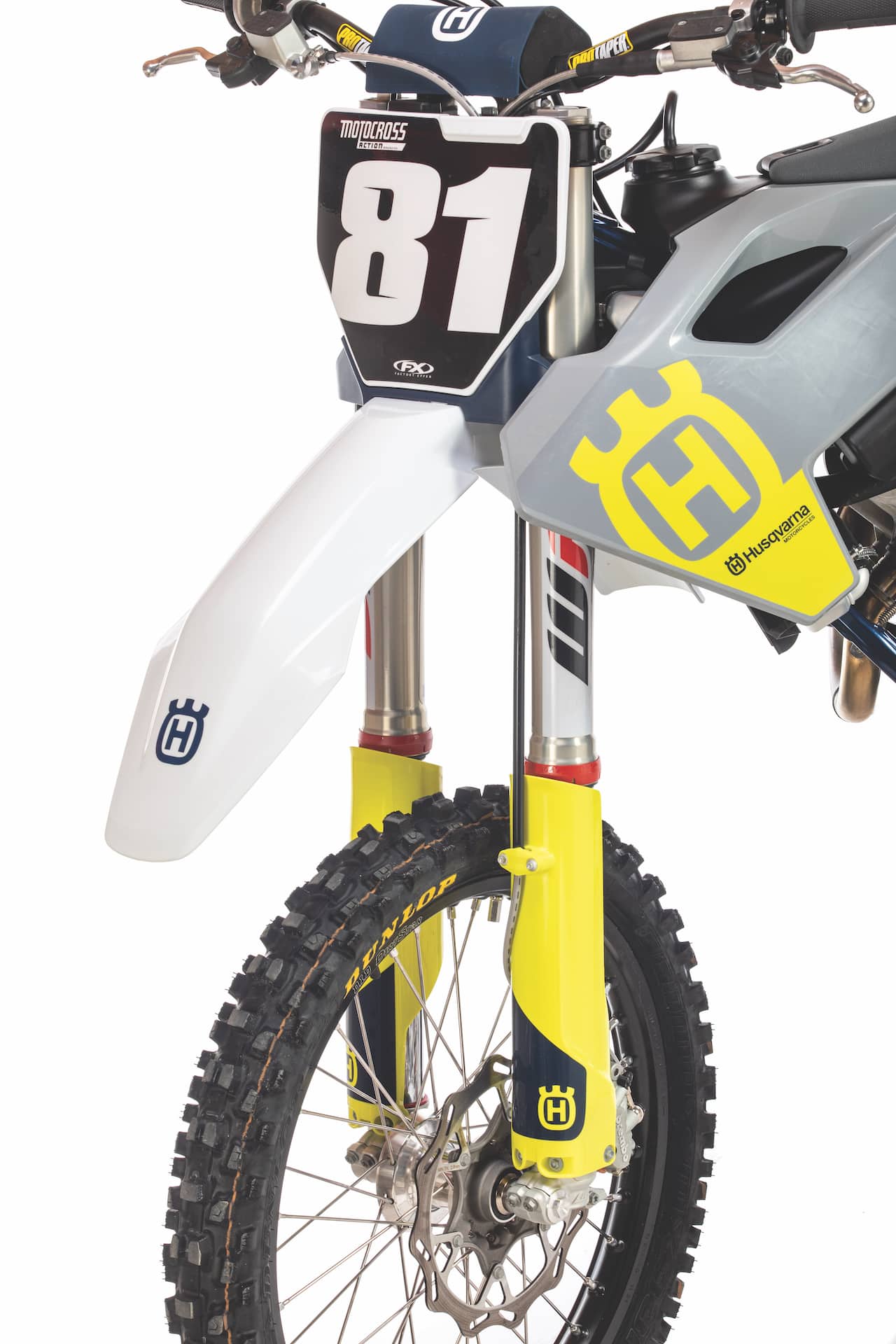
WP XACT AIR FORK SETTINGS
The WP XACT air forks are 10mm shorter on the 2023 FC250 in comparison to the KTM, and we love them. They stick to the ground and corner with ease. Keep in mind, our WP XACT air forks took about five hours to feel good, and it was ten hours before the frame came around. For hardcore racing, these are MXA’s recommended 2023 Husqvarna FC250 fork settings (stock settings are in parentheses):
Spring rate: 156 psi (10.8 bar)
Compression: 9 clicks out (12 clicks out)
Rebound: 16 clicks out (18 clicks out)
Fork-leg height: Second line
Notes: As always, remember that the air chamber in your left-side fork leg is your spring rate. Just because you’re fast doesn’t mean you need a massive amount of air. By the same token, just because you’re slow doesn’t mean you should run your air pressure too low. The air pressure holds your forks up in the position they were designed to work in. The clickers control how quickly they compress and rebound.
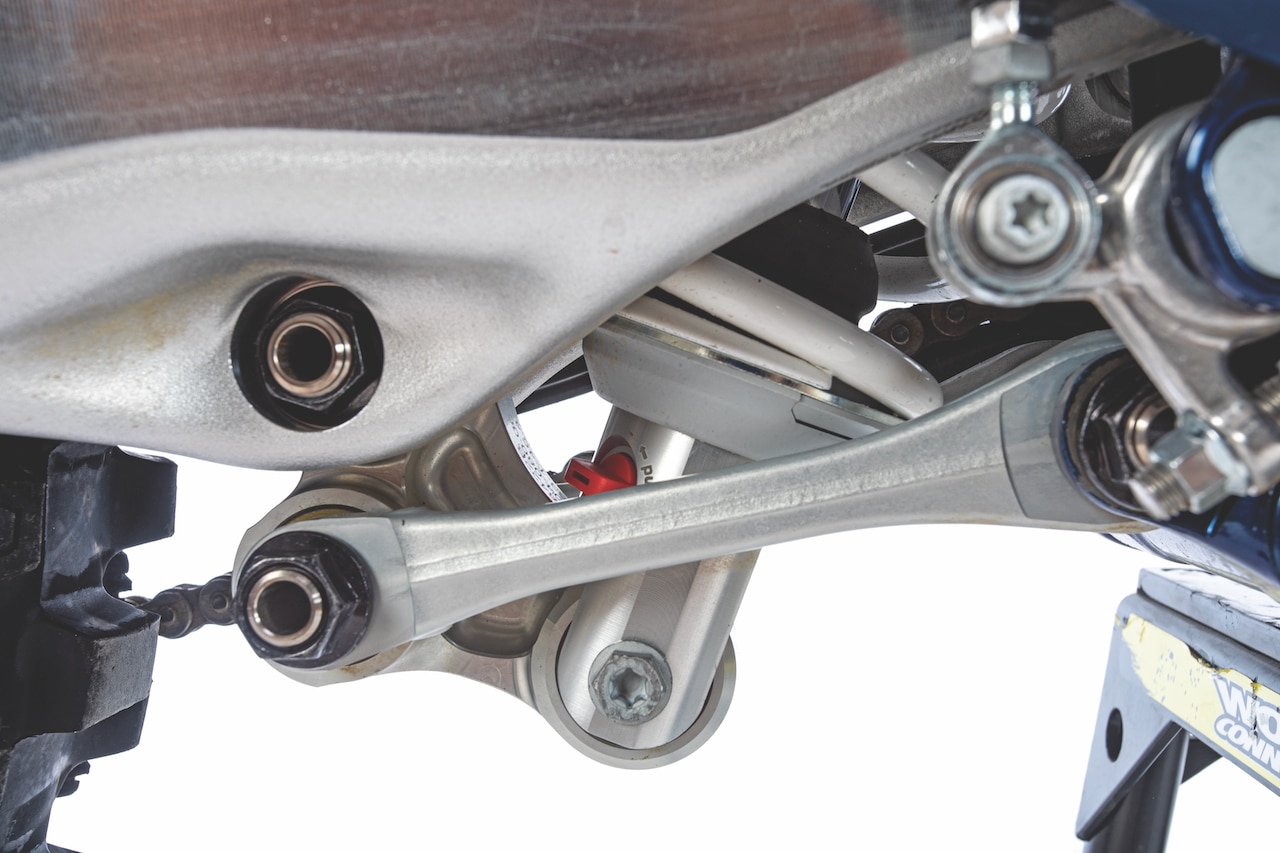
WP SHOCK SETTINGS
We have always had good luck with Husqvarna FC250 rear suspension, but that doesn’t mean we haven’t had issue. For 2023 we think that the risisng rate at the very end of the shock curve is not firm enough. In the last couple inches of rear wheel travel the rear end seems to drop too quickly. When this happens in G-outs, jump faces and hard landings the rear end tends to kick to one side. We relied on stiffer low-speed compression settings to help fight this. For hardcore racing, these are MXA’s recommended 2023 Husqvarna FC250 shock settings:
Spring rate: 45 N/mm (for 175 pounds and up) 42 N/mm (for riders under 175 pounds)
Race sag: 105mm
Lo-compression: 8 clicks out (12 clicks out)
Hi-compression: 1-1/2 turns out
Rebound: 14 clicks out
Notes: If your bike is brand new, check the sag. If your suspension was serviced, check the sag. If your suspension has been broken in, check the sag. If you’ve taken a few months off, check the sag. Having your sag in the correct position will protect you from lots of tail-chasing. I wouldn’t hurt to check the shock linkage bearings for signs the needles walking out.


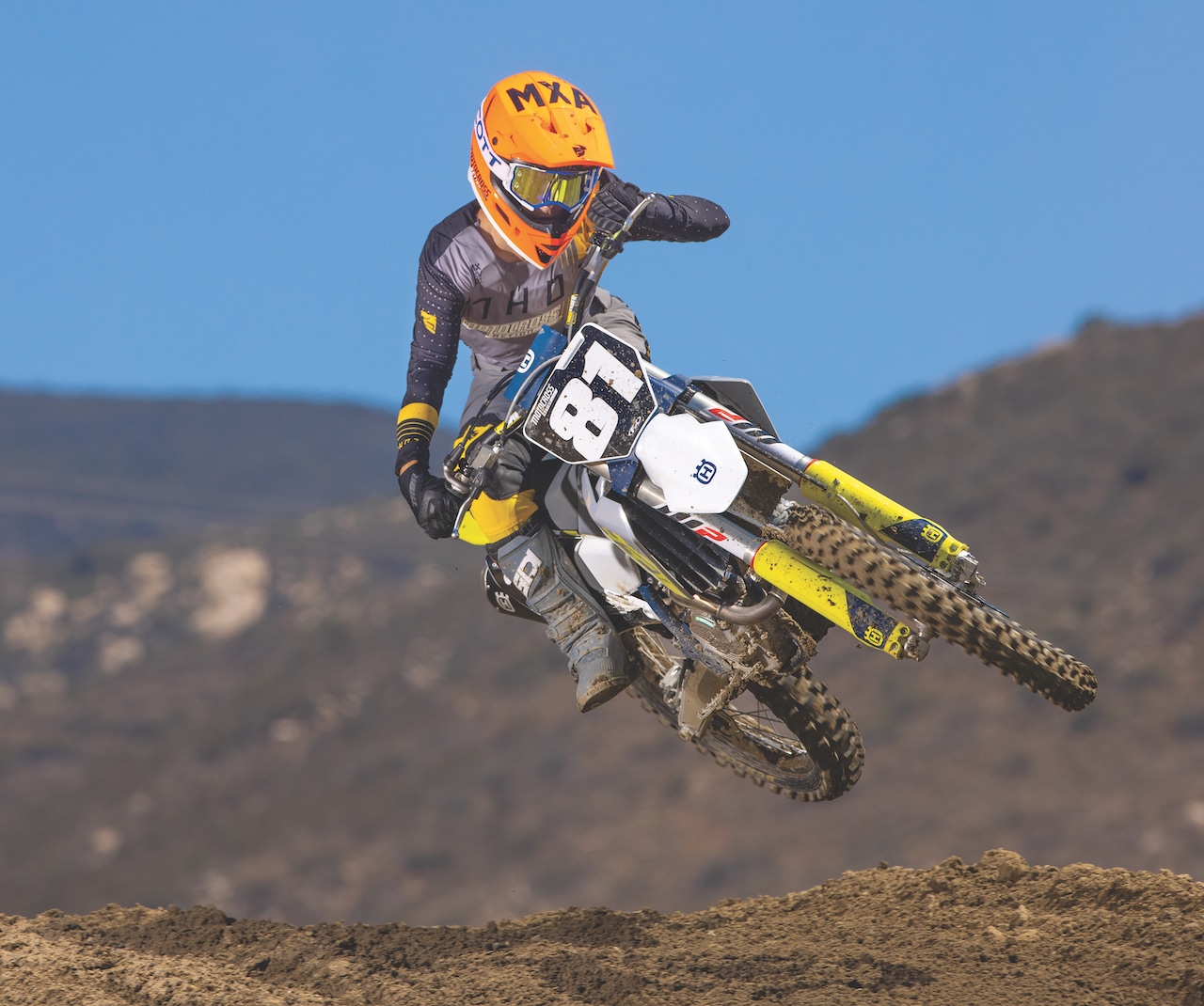
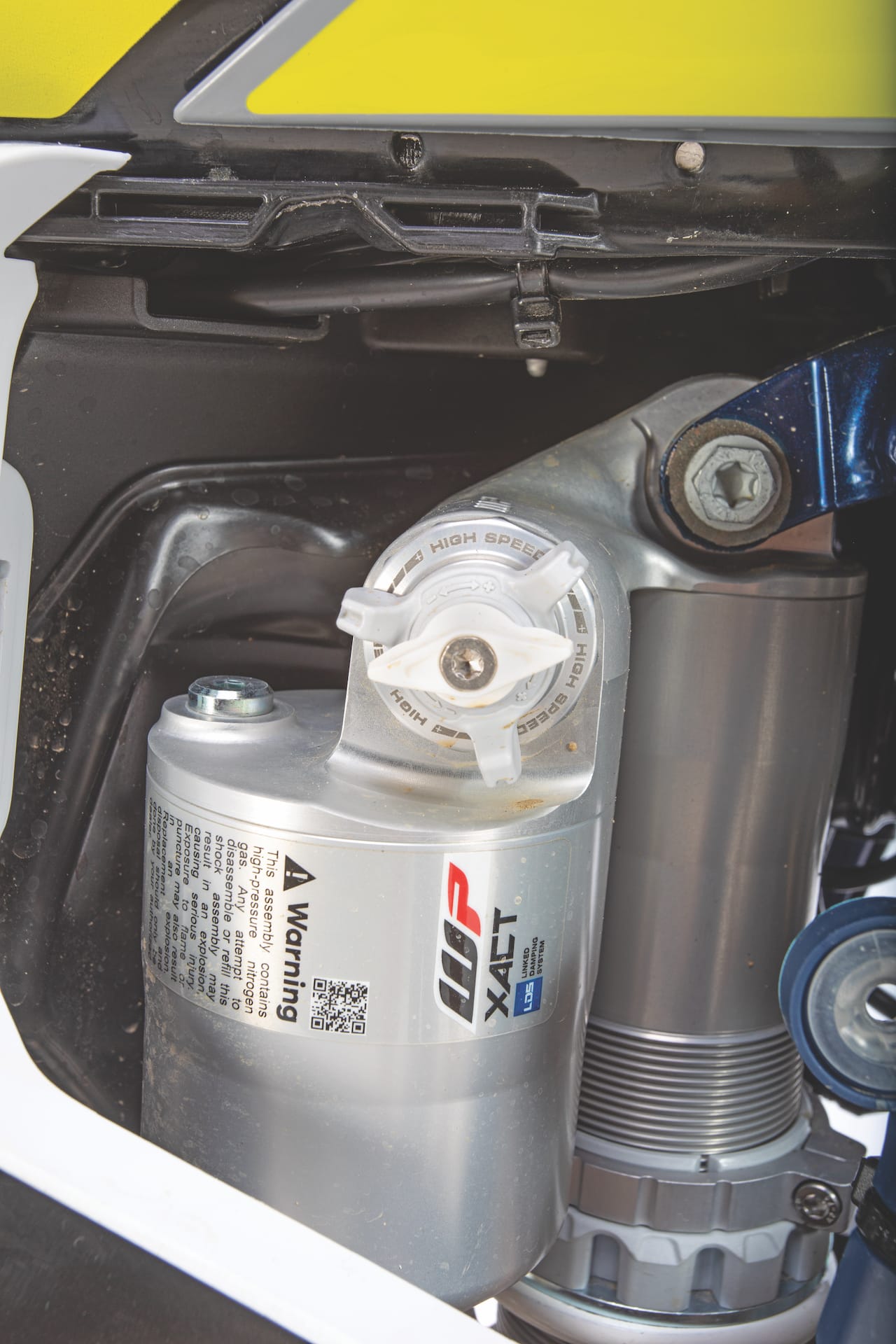



Comments are closed.